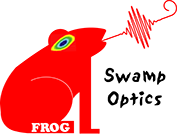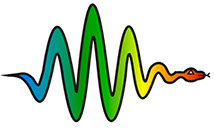Pulse-Compression
When ultrashort pulses propagate through material (even simple glass), they spread in time due to group-delay dispersion (GDD). The red colors propagate faster than blue colors, lengthening the pulse—we say that the resulting pulse becomes chirped—one of the reasons we need to measure it. For an idea of what a chirped light pulse looks like, see the pulse at left below. Fortunately, devices called pulse-compressors exist that have negative GDD and so compensate for the positive GDD of materials.

A chirped pulse propagating through a four-prism pulse-compressor.
Schematic of the conventional four-prism pulse-compressor. Thick arrows indicate the alignments necessary to achieve proper operation. Notice that it's not a trivial matter to align one of these devices!
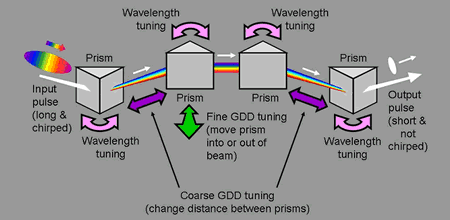
Unfortunately, if not aligned perfectly, the pulse-compressor can introduce its own distortions: spatial chirp and pulse-front tilt. We've found that most pulses are contaminated with these distortions. Why? Unfortunately, when the pulse wavelength is tuned or the input beam wanders even a bit, all four prisms must be rotated in order to precisely maintain the same incidence angles (thick pink arrows). But you also need to tune the GDD according to the amount of chirp in your pulse. Unfortunately, coarse and fine GDD-tuning are separate. Coarse-tuning the GDD (which is really all that you need) requires changing the separations between the first two and last two prisms, maintaining them precisely equal (thick purple arrows). If any of the prisms has a different incidence angle, then the output pulse will have spatio-temporal distortions. As a result, coarse-tuning is not practical. All that can be done is fine-tuning, which is achieved by moving a prism into or out of the beam (the green arrow).

Conventional two-prism pulse-compressor
Fortunately, researchers realized quickly that they could reduce the number of prisms to two. This avoids the need for maintaining equal prism separations (note only one thick purple arrow). Unfortunately, when the wavelength of the input pulse is tuned or the input beam wanders, both prisms must still be rotated in order to maintain equal prism incidence angles (thick pink arrows). So coarse-tuning remains impractical and fine-tuning the GDD is all that can be done. This also limits a given compressor to a small range of bandwidths (see below).
BOA single-prism pulse compressor
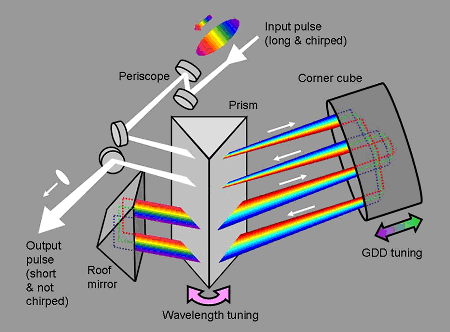
Swamp Optics' new single-prism (BOA--Bother-free Optimal Arrangement) pulse-compressor solves all of these problems. The precisely manufactured corner-cube retro-reflector reflects the beam back precisely parallel with the beam entering it. Also, it inverts the beam, so it isn't necessary to invert the prism. This avoids all the distortions of two- and four-prism designs. Also, note that only the one prism angle needs to be rotated when the input wavelength is tuned, and only one distance (the prism-corner-cube distance) needs to be changed to tune the GDD. Even better, because the distance between the prism and corner cube is double-passed, the BOA compressor is half as large as an equivalent two-prism compressor. This simplicity yields a more compact, more convenient, non-distorting, and much less expensive device. And it works beautifully!
Yet another advantage of the BOA compressor is that, unlike all other pulse-compressors, it can be used with either broadband or narrowband pulses. The bandwidth of a prism pulse-compressor is limited by beam cropping of the angularly dispersed beam at the second prism (or at the second pass through the single prism in the case of the BOA). The greater the bandwidth of the pulse and the greater the prism separation (i.e., the required GDD), the more potential for such cropping. Conventional pulse-compressors tune the GDD by inserting one of the prisms into or out of the beam and always operate at their maximum prism separation. As a result, designing a conventional pulse-compressor requires committing to a pulse bandwidth and maximum negative GDD. Conventional narrowband compressors achieve large negative GDD, but cannot be used with broadband pulses. Conventional broadband compressors can be used for narrowband pulses, but they achieve only limited negative GDD. The BOA, on the other hand, tunes the GDD by translating the corner cube, thus varying the prism separation. This allows it to simultaneously operate at a large separation (GDD) for narrowband (<40 nm) pulses and also for broadband (>100 nm) pulses (which require less separation and GDD). Thus the BOA is much more versatile and can be used for many pulses. If you currently have a narrowband ~100fs system but are thinking of going to a broadband ~10fs system, you don't need to decide between two different compressors; one BOA will work for both systems! See below.
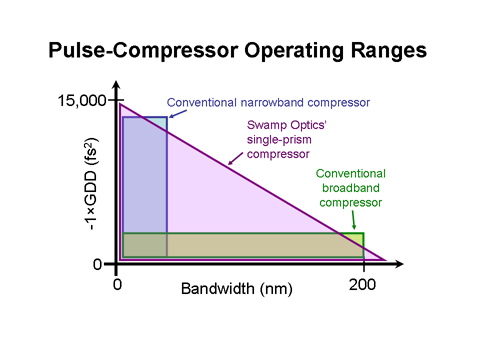
Operating range for the BOA compressor compared to conventional pulse-compressors. Note that, unlike traditional pulse-compressors, which tune the GDD by moving a prism into and out of the beam, the BOA can be used for both broadband and narrowband pulses. This is because it tunes the GDD by moving the corner cube, effectively changing the distance between the prisms of a multi-prism device--something that is impossible with a standard device.
PDF summary of Pulse Compression
Copyright © 2022 Swamp Optics, LLC. All Rights Reserved.
